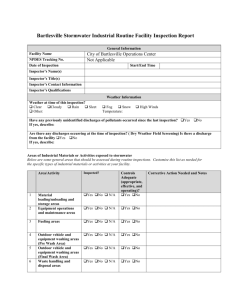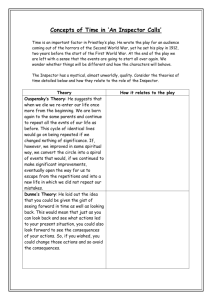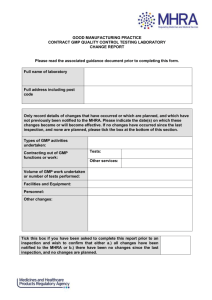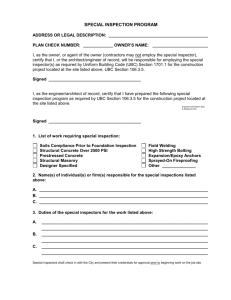Existing system compliance inspection Manual
advertisement
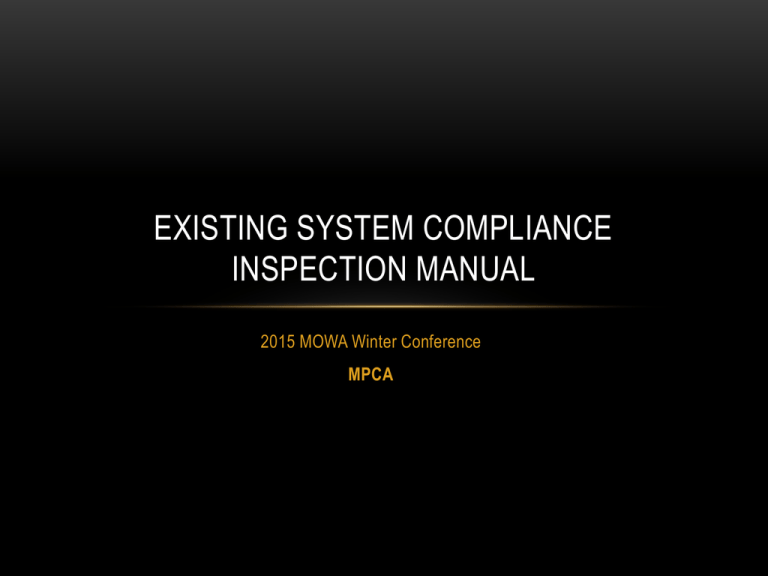
EXISTING SYSTEM COMPLIANCE INSPECTION MANUAL 2015 MOWA Winter Conference MPCA ANY MAJOR TOPIC MISSING? • Chapter One: Compliance Criteria for Existing Subsurface Sewage Treatment Systems • Chapter Two: Introduction to Compliance Inspections • Chapter Three: Licensing and Certification Requirements for Existing System Compliance Inspections • Chapter Four: Inspection Protocol • Chapter Five : Reporting • Chapter Six: Underground Injection Control (Uic) Wells Compliance Inspections • Chapter Seven: Homeowner Guidance • State rules do not provide methodologies on how to conduct an existing system compliance inspection. This manual is offered to provide you with suggested methodologies to adequately assess the compliance status of existing SSTS. • Bottom line – the final answer of the compliance status must be correct. VARYING CRITERIA • If the LGU has different compliance criteria than the state, then the system needs to be assessed against both criteria. • Therefore the system can be issued a certificate of compliance for one of the criteria and a notice of non-compliance for the other criteria. • The regulatory “weight” in this situation depends on the requirements that triggered the inspection. For example, if the LGU ordinance required a certificate of compliance for a property transfer, then the compliance requirements of the LGU apply. If the inspection was conducted for a bedroom addition (a state trigger), then the system has to meet the state criteria WHO CAN DO THE WORK? • A maintainer cannot sign a certificate of compliance for a holding tank • However, it is acceptable if the LGU inspector wants to issue a COC based on the take the maintainer’s report ADVANCED INSPECTION • A basic inspector can inspect Type I components of a larger SSTS or SSTS with advance treatment, but they must not issue a COC or NON. An advanced inspector must be willing to accept the basic inspector’s work and must sign the required forms. DISCUSSION QUESTION – SYSTEM OWNER • What questions do you ask of the system owner? DISCUSSION QUESTION - TANKS • What are some tricks to find the tank(s)? DISCUSSION QUESTION – SOIL SYSTEM • What are some of the tricks to find the soil system? DISCUSSION QUESTION – UNFOUND COMPONENTS • What happens if you cannot find one or any components? DISCUSSION QUESTION – TYPE III • Do you do anything special if you know the soil system is not standard? • Undersized • Disturbed soil • Less than one foot of good soil DISCUSSION QUESTION – HYDRAULIC TEST • Do you perform hydraulic tests? • If so, how do you do it? DISCUSSION QUESTION – IS IT SEWAGE? • How do you know if a suspect pipe is discharging sewage or something else? DISCUSSION QUESTION – STRAIGHT PIPE • What do you think of the statement?: If a discharge is suspected due to being the common practice in an area, and there is evidence that the dwelling does not have a system then the inspector could consider the system to be a straight pipe system (a subclass of an ITPHS). DISCUSSION QUESTION – STRAIGHT PIPE • How do you determine if the system has a straight pipe? DISCUSSION QUESTION – HYDRAULIC TEST • How do you know if sewage is backing-up into the building? DISCUSSION QUESTION – HYDRAULIC TEST • What do you think of the statement?: • It is recommended that a system component that chronically freezes in the winter causing sewage back-up be considered an ITPHS. DISCUSSION QUESTION – CHEMICALS • What do think the compliance status of the tank if it is found to be “dead”? DISCUSSION QUESTION – TANK • Do you think a non-certified maintainer should be able to make a watertight tank determination? DISCUSSION QUESTION – TANK • Can a watertight determination be made without pumping the tank? DISCUSSION QUESTION – SOIL COLOR • Would you accept a past soil boring which does not have Munsell color notations? • 0 to 10” – Black Topsoil • 10” to 20” – Brown sand • 20” to 30” – Light brown sand DISCUSSION QUESTION – SOIL COLOR • What do you think of the statement: • One boring must be taken in what is perceived as the most limiting area. PRETREATMENT DEVICE • If system has an operating permit, device must meet the operating permit standard to be in compliance. • If the system does not have an operating permit, any performance level was assumed during design, is the compliance standard. • If no operating permit or assumed design standard exists, and the system does not meet the design requirements for a modern Type IV system concerning the treatment device, distribution network and vertical separation distance, the inspector can weigh these factors in determining system compliance. DISCUSSION QUESTION - PRETREATMENT • What methods do you use to check the operation of the pretreatment device? DISCUSSION QUESTION - WINTER • What conditions are needed to do a compliance inspection in the winter? SYSTEM NO LONGER IN USE • MN statutes 115.55 requires a disclosure if a system-not-in-use has been properly abandoned. • It may be extremely difficult to determine the presence and location of a system-no-longer-in-use • At a minimum the inspector needs to ask the property owner if they have knowledge of a system that is no longer in use. REPORTING • If a mistake or omission is discovered in an existing system compliance inspection, the report should be amended and marked as an updated report. Older reports should not be destroyed, but should be marked that it is outdated and list the date of the most recent inspection report. QUESTIONS
